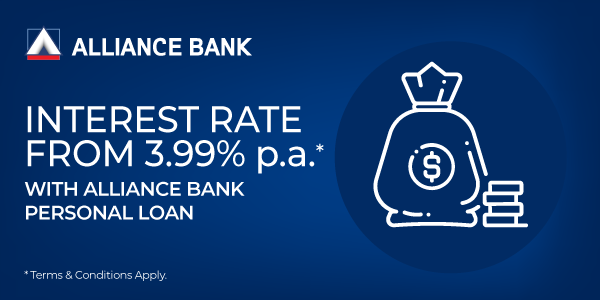Everything You Need To Know About Balance Transfer Plans

If you ever find yourself neck-deep in credit card debt, repaying what you owe will become a challenge. While not a leading cause of bankruptcy, credit card debt accumulates very easily, making it very difficult to pay off if you aren’t careful.
Remember, any outstanding balance that isn’t paid off after the 20 days grace period is charged interest. The interest rate charges for any outstanding balance on your credit card are compounded daily according to a tiered interest rate system. Most credit cards charge interest using this tier:
- 15% p.a. – if you pay your credit card bills on time for 12 consecutive months
- 17% p.a. – if you pay your credit card bills on time for 10 out of 12 months
- 18% p.a. – if you don't pay your credit card bills on time at least 10 out of 12 months
If your credit card is charged an interest of 17% p.a., that means your outstanding balance will increase by 0.0466% every day until all your debt is cleared. Think that's an insignificantly negligible number? Think again.
Understanding Compound Interest

Compound interest is generally defined as "interest earned on top of accumulated interest". It may sound complicated, so is better explained with an example. If Michael set aside RM5,000 to an automatically-renewing fixed deposit account at 4% per annum, here’s how much he’d earn over 10 years:
| Year | Beginning Balance | 4% Interest Gain | End Balance |
| 1 | 5,000.00 | 200.00 | 5,200.00 |
| 2 | 5,200.00 | 208.00 | 5,408.00 |
| 3 | 5,408.00 | 216.32 | 5,624.32 |
| 4 | 5,624.32 | 224.97 | 5,849.29 |
| 5 | 5,849.29 | 233.97 | 6,083.26 |
| 6 | 6,083.26 | 243.33 | 6,326.60 |
| 7 | 6,326.60 | 253.06 | 6,579.66 |
| 8 | 6,579.66 | 263.19 | 6,842.85 |
| 9 | 6,842.85 | 273.71 | 7,116.56 |
| 10 | 7,116.56 | 284.66 | 7,401.22 |
The "interest gain" column is an illustration of compound interest at work. Similarly, it works in the opposite direction too.
Let’s say Michael has accumulated an outstanding balance of exactly RM5,000. To clear it off, he decided to stop using his credit card and make minimum payments of RM200 every month. Guess how long will he need to repay that outstanding balance?
25 months? Nope. Thanks to compounding interest charges on the outstanding balance, it’ll take him a total of 31 months to repay the full amount, which includes RM1,108 just on interest charges. That’s right: he’d have paid 22.16% extra from that initial RM5,000. Plus, is there really a guarantee that he won’t use his credit card during this period?
So, is there a better way to repay credit card debt? As it turns out, there is.
What Is A Balance Transfer For Credit Cards?

As the name implies, a balance transfer plan allows you to transfer the outstanding balance from one credit card to another – and repay them in instalments at a low-interest rate. Sometimes, it can even be at 0% interest – a double win situation for the cardholder.
Banks will generally allow an individual to perform a single balance transfer with up to 3 different credit cards. You can choose how much of the outstanding balance to transfer, but usually, banks will set the minimum as well as maximum amounts that you can transfer. The maximum amount is usually equivalent to 80% of the credit limit of the credit card you are transferring to.
Most of the time, banks will charge a small one-time fee on the total transfer amount and include it in the monthly repayment amount. This fee doesn’t compound over time since it is not an interest charge, so even if the bank charges a fee of 1% of the total balance transfer amount, it’s still a small, fixed amount compared to the tiered interest charge if you didn’t use a balance transfer. Sometimes, there’ll be balance transfer promotions where the bank would offer 0% interest and 0% fee too!
In addition, most banks also allow users to make early settlements of their balance transfer amount. If after a period of time you wish to pay off the entire remaining amount, you can call the bank and do so. However, this will usually incur an early settlement fee that can go up to RM100 – so it may not really be worth doing.
To illustrate just how much you save with balance transfers, let’s take the example of Michael from earlier. By using a balance transfer plan to repay his RM5,000 debt over 24 months at 0% interest and a one-time fee of 1%, Michael only needs to pay RM210.42 every month for two years. That’s just an extra RM50 in balance transfer fees, and a whopping RM1,058 less than letting the interest charge compound as per our earlier example.
Why Do Banks Offer Balance Transfer?

From a bank’s perspective, balance transfer facilities offer a two-pronged advantage. By taking on your outstanding credit card debt, a bank denies another bank from profiting off your debt… and make a (lesser) profit for itself via the one-time fees. And, if you cannot afford the monthly instalment, that amount is subjected to the regular tiered interest charge – therefore profiting the bank once more.
That said, banks also take on some risk with balance transfers. If an individual is declared bankrupt and his or her remaining assets are not enough to pay off the outstanding debt, the bank will have no choice but to wipe the total amount off as bad debt.
If all that sounds grim, know that as with every financial product, you can actually save money by using credit card balance transfers. We’ll explore this in a separate article.
How To Apply For Balance Transfer?

Unlike other financial products, applying for a balance transfer is still old-school. If you’d like to apply for a balance transfer to your credit card issued by Bank A, you’ll first need to get the application form; it’s usually available on the bank’s website.
The form will require all information necessary for the balance transfer. If you’re trying to transfer the outstanding balance from two credit cards issued by Bank B and Bank C, you’ll need to fill them out in the form, and include the amount you’d like to transfer. You’ll also need to include credit card A’s details as the recipient. Finally, other customer details like your full name, IC number, email, and phone number will be required.
Once all that is filled up, you will need to send it via snail mail or fax to Bank A – the form will provide the necessary addresses. Some banks may allow e-mailing the forms, too. After a few working days, Bank A will contact you regarding the status of your application.
If successful, you will receive some form of written notice from Bank A. You will also see the outstanding balance from credit cards B and C reduced based on the amount you requested to transfer. In the following month’s statement for credit card A, you will see a deduction for the monthly repayment. This will appear every month until the end of the agreed balance transfer payment duration.
Use Balance Transfers Responsibly

Balance transfers aren’t just designed for those in debt. Like other financial products, they are extremely helpful – as long as they are used responsibly. Balance transfers will give the impression that you can afford a lot more than what you actually can, because the monthly repayment will be tiny compared to the total amount.
If you’re thinking of using balance transfers to help with your credit card debt, don’t think that you’re out of the woods just because your balance transfer application is successful. It doesn’t mean you now have the ability to be less financially responsible in any way. Don’t forget that if you cannot pay off the monthly repayment, the outstanding amount is subjected to standard credit card interest charge.
So exercise plenty of restraint and think of the big picture – or you’ll just end up digging a bigger hole than the one you were in. To compare the different balance transfer credit card plans in Malaysia, use our RinggitPlus comparison tool and find the best balance transfer plan for you.


























